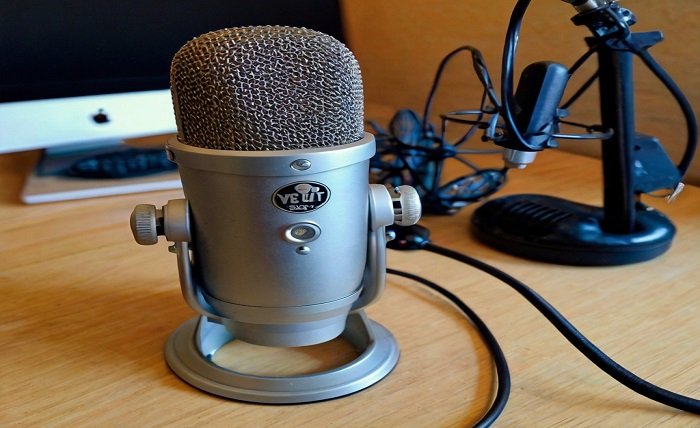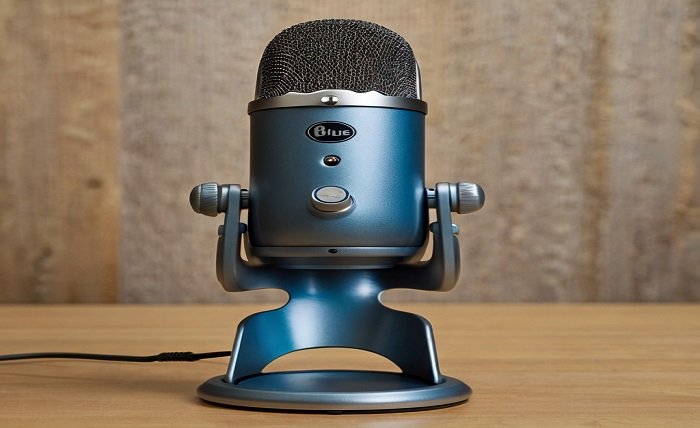The Blue Yeti Microphone has completely changed the industry, enabling everyone to record and transmit high-quality audio, from pros in podcasting to casual streamers. The Blue Yeti Microphone, well-known for its outstanding clarity and adaptable functions, has established itself as a mainstay in the equipment arsenal of content producers worldwide. This tutorial will cover the main features, what sets the Blue Yeti Microphone apart, and how to make the most of this amazing tool.
The Blue Yeti Microphone: Why Choose It?

For a variety of reasons, the Blue Yeti Microphone is a notable option when it comes to microphones. It is a customer favorite due to its professional-grade audio quality, affordability, and ease of use. The Blue Yeti Microphone, in contrast to many other microphones in its price range, has a variety of functions to meet a range of recording purposes, including voiceovers, podcasts, music, and gaming.
There are essential elements of the Blue Yeti Microphone
Several characteristics make the Blue Yeti Microphone stand out from its competitors. These consist of an integrated headphone port for zero-latency monitoring, gain control, and many recording patterns. The Blue Yeti Microphone also has a tri-capsule array, which enables the best possible sound capture in any setting. The adaptability of the Blue Yeti Microphone ensures excellent audio quality, whether you’re recording a group interview or a solo podcast.
Setting up the Blue Yeti Microphone
Even novices may use the Blue Yeti Microphone since it is simple to set up. First, use the USB cord that comes with the Blue Yeti Microphone to connect it to your computer. After connecting, go to the audio settings on your computer and choose the Blue Yeti Microphone as your input device. Operating systems Mac and Windows are both compatible with the Blue Yeti Microphone, guaranteeing smooth integration with your configuration.
Change the settings on your Blue Yeti microphone
A variety of programmable options are available with the Blue Yeti Microphone to improve your recording experience. The Blue Yeti Microphone has four distinct polar patterns: cardioid, bidirectional, omnidirectional, and stereo, so you may customize the sound capture to meet your unique requirements. To ensure clear and crisp sounds, use the gain control to control the microphone’s sensitivity and avoid distortion.
We are using the Blue Yeti Microphone to record
The Blue-Yeti Microphone’s high-quality parts and user-friendly design make recording a snap. For best results, position the Blue Yeti Microphone on its stand or install it on a suitable boom arm. Make sure the microphone is polar pattern-matched to the recorded environment. The LED mute button on the Blue Yeti Microphone gives you fast control and hassle-free recording pauses.
Ensuring the Blue Yeti Microphone Produces the Best Audio
To get the best audio quality possible with the Blue-Yeti Microphone, take into account your recording settings. To reduce background noise and plosive sounds, use a foam windshield and a pop filter. To guarantee even sound capture, place the Blue-Yeti Microphone consistently 6 to 12 inches away from your lips. To identify any problems early, use the headphone jack on the Blue-Yeti Microphone to regularly check your recordings.
The Blue Yeti Podcasting Microphone
Podcasters frequently use the Blue-Yeti Microphone because of its dependable performance and adaptability. Its cardioid mode, with its ability to minimize background noise and capture crystal-clear audio from the front, is ideal for solo recordings. To capture voices from both sides of the microphone during an interview, switch to the bidirectional mode. The Blue Yeti Microphone is a powerful tool for producing polished and captivating podcasts because of its professional sound quality and ease of use.
The Blue Yeti serves as a gaming and streaming microphone
Gamers and streamers are another group that greatly benefits from the Blue-Yeti Microphone. Its excellent audio capture makes streaming more immersive and improves the viewing experience. The Blue-Yeti Microphone’s plug-and-play design ensures quick setup, freeing you to focus on your content. Choose the omnidirectional pattern for group sessions or the cardioid pattern for solo streaming to ensure a clear capture of every voice.
We are addressing common issues with the Blue Yeti Microphone
Even though the Blue-Yeti Microphone is usually dependable, problems might occasionally arise. Common concerns include audio distortion, background noise, and connection challenges. Ensure that you have correctly connected your computer to the Blue-Yeti Microphone and set it as the input device. Use noise reduction techniques to minimize unwanted noises, and adjust the gain control to avoid distortion. For more troubleshooting advice, see the user manual or internet resources for the Blue Yeti Microphone.
This guide explains how to take care of your Blue Yeti microphone
Your Blue-Yeti Microphone’s durability and functionality depend on proper maintenance. Use a soft cloth to keep the microphone dust-free and clean. Keep the Blue-Yeti Microphone away from excessive heat or moisture. When not in use, store the Blue-Yeti Microphone in its original packaging or a protective case. To maintain the best possible performance out of your Blue-Yeti Microphone, periodically check for firmware upgrades.
You are adding to and changing out your blue Yeti microphone
Upgrades and other accessories will make your Blue-Yeti Microphone experience even better. To lessen vibrations, think about purchasing a shock mount and a boom arm for adjustable placement. The use of a foam windshield and pop filter may greatly enhance audio quality by cutting down on background noise and plosives. An external audio interface can further expand your Blue-Yeti Microphone’s functionality in professional settings.
In summary
Anyone wishing to create audio content of high caliber will find the Blue-Yeti Microphone to be an adaptable and trustworthy instrument. The Blue-Yeti Microphone has all the features and performance that a podcaster, streamer, musician, or content producer needs to improve their recordings. You can make sure that the Blue-Yeti Microphone works well for you for many years to come by being aware of its primary characteristics, fine-tuning your setup, and taking care of the microphone.
FAQ
What is the Blue-Yeti Microphone’s ideal recording pattern? Your unique requirements determine the ideal recording pattern. For recordings made alone, the cardioid pattern works well. Use the omnidirectional pattern for group recordings and the bidirectional pattern for interviews.
How can I use the Blue-Yeti Microphone to cut down on background noise? To cut down on background noise, use a pop filter and foam windshield, place the microphone properly, and record in a peaceful location. You can also minimize unwanted noises by adjusting the gain control.
Can I connect my smartphone to the Blue-Yeti Microphone? With the right USB adaptor, you may use the Blue-Yeti Microphone with a smartphone. Make sure the adapter can accept audio input and is compatible with the charging port on your phone.
How do I upgrade my Blue-Yeti Microphone’s firmware? For firmware upgrades, consult the user manual or the Blue Yeti website. To ensure that your microphone operates at its best, download and update the most recent firmware by following the instructions.
Which add-ons for the Blue-Yeti Microphone are suggested? A shock mount, boom arm, pop filter, foam windshield, and an external audio interface are among the suggested add-ons. These provide more placement and recording versatility, as well as improved audio quality.

